Click on images to enlarge
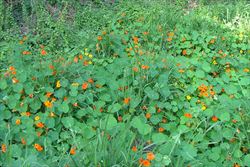
infestation growing in bushland (Photo: Sheldon Navie)
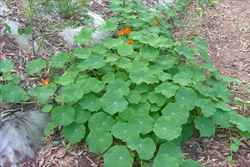
infestation growing in a revegetation area (Photo: Sheldon Navie)

habit (Photo: Sheldon Navie)
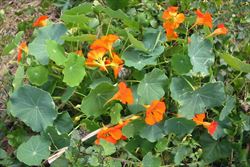
habit in flower (Photo: Sheldon Navie)
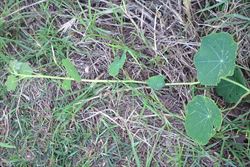
creeping stem (Photo: Sheldon Navie)
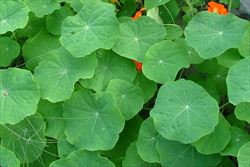
leaves (Photo: Sheldon Navie)
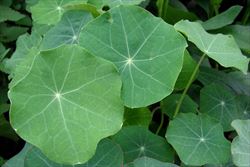
close-up of round leaves, with leaf stalks attached to their undersides (Photo: Forest and Kim Starr, USGS)
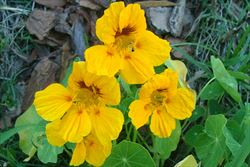
flowers (Photo: Sheldon Navie)
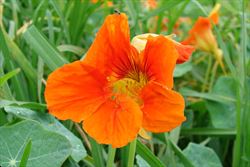
close-up of bright orange flower with lower petals fringed at the base (Photo: Forest and Kim Starr, USGS)
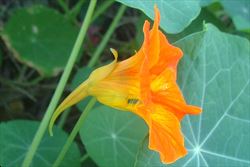
close-up of flower from side-on showing spurred sepals (Photo: Sheldon Navie)
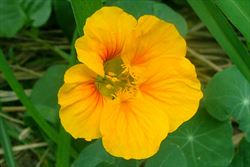
close-up of bright yellow flower (Photo: Sheldon Navie)
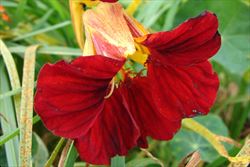
close-up of red flower (Photo: Forest and Kim Starr, USGS)
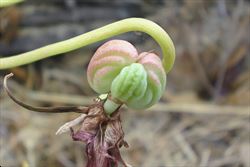
close-up of ribbed immature fruit (Photo: Sheldon Navie)
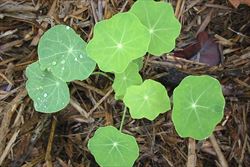
young plant (Photo: Sheldon Navie)
Scientific Name
Tropaeolum majus L.
Family
Tropaeolaceae
Common Names
garden nasturtium, Indian cress, nasturtium, tall nasturtium
Origin
This species comes from South America. However it does not grow in the wild, only being reported from cultivated and naturalised populations. It is thought to be a hybrid between Tropaeolum ferreyrae and Tropaeolum minor, both of which are native to the Andes region in western South America (i.e. Ecuador and Peru).
Cultivation
Nasturtium (Tropaeolum majus) is a widely grown garden plant (i.e. ornamental), particularly in the wetter parts of the country. Numerous cultivars are available with flowers in a wide variety of colours (yellows, oranges and reds are most common).
Naturalised Distribution
Nasturtium (Tropaeolum majus) has become widely naturalised in the coastal districts of southern and eastern Australia (i.e. in south-eastern Queensland, the coastal districts of central and northern New South Wales, southern Victoria, south-eastern South Australia and the south-western and western parts of Western Australia). Also naturalised on Lord Howe Island.
Widely naturalised overseas in southern Africa (e.g. Zimbabwe), the Canary Islands, Europe (i.e. Portugal, Hungary, the UK, Denmark and Finland), New Zealand, Hawaii and some parts of the USA (i.e. California, Virginia, Pennsylvania, New Hampshire and Massachusetts).
Habitat
A weed of watercourses (i.e. riparian vegetation), urban bushland, roadsides, railways, gardens, disturbed sites and waste areas.
Habit
A short-lived (i.e. annual or biennial) herbaceous plant with creeping (i.e. prostrate) or sprawling stems growing 0.5-2 m long.
Distinguishing Features
- a short-lived herbaceous plant with creeping or sprawling stems that are somewhat fleshy.
- its and rounded leaves (4-15 cm across) have entire or slightly lobed margins.
- these leaves are borne on long stalks that attach to the centre of their undersides.
- its showy orange, yellow or red flowers (2.5-7 cm across) have a long and narrow spur (2.5-4 cm long) at the base.
- its fleshy pale green fruit (about 10 mm long) split onto three ribbed 'seeds'.
Stems and Leaves
The stems and leaf stalks (i.e. petioles) are pale green in colour, hairless (i.e. glabrous) and somewhat fleshy (i.e. succulent).
The green or slightly bluish-green leaves are borne on stalks (i.e. petioles) 5-30 cm long that are attached to the centre of the leaf undersides (i.e. the leaves are peltate). These leaves (4-15 cm across) are rounded in shape (i.e. orbicular) with entire, wavy (i.e. undulate), or slightly lobed (i.e. sinuate) margins. The leaves are hairless (i.e. glabrous) and have several prominent veins that radiate outwards from the centre of the leaf blade.
Flowers and Fruit
The flowers are borne singly in the upper leaf forks (i.e. axils) on stalks (i.e. peduncles) 15-25 cm long. These flowers (2.5-7 cm across) have five yellow, orange or red petals (2.5-6 cm long) and five sepals (1-2 cm long) that are fused together at the base. One of these sepals is formed into a nectar-bearing spur (2.5-4 cm long) that is either straight or slightly curved. The flowers also have eight stamens and an ovary topped with a style and stigma. Flowering occurs mostly in spring, but also in summer and autumn.
The fleshy (i.e. succulent) fruit (about 10 mm long) separate into three one-seeded segments (i.e. mericarps) when mature. These 'seeds' (i.e. mericarps) are pale green in colour and prominently ribbed on one side.
Reproduction and Dispersal
This species reproduces by seed and vegetatively via pieces of its fleshy (i.e. succulent) stems.
The seeds and stem segments are probably spread by water and in dumped garden waste.
Environmental Impact
Nasturtium (Tropaeolum majus) is regarded as an environmental weed in Victoria, South Australia, New South Wales, Queensland and Western Australia.
Legislation
Not declared or considered noxious by any state government authorities.

